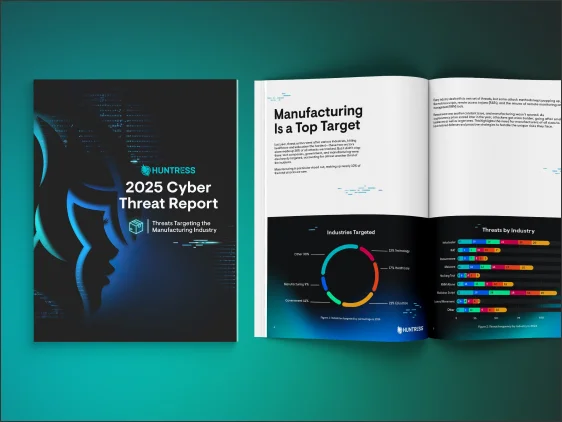How Huntress Protects Manufacturing & Construction Operations
Protect Your Company's Technology Infrastructure
Manufacturing and construction companies are prime targets for cyberattacks because your operations are so critical. You may be vulnerable to ransomware and extortion, especially if you haven't traditionally invested in cybersecurity. Plus, your interconnected networks and big financial transactions make them attractive to hackers, leading to potential supply chain breaches and big financial losses.
Leave your network and system security to experts that can keep watch for you 24/7 so you can focus on your day-to-day operations with peace of mind.
- Huntress solves cyber risks for manufacturing and construction by streamlining your security while ensuring compliance with industry regulations.
- Our team provides around-the-clock monitoring to detect and contain suspicious activities and notifies you only when action is needed on your end.
- You can also configure the platform to automatically remediate issues, keeping your operations secure and uninterrupted.
- We also offer training that can educate your staff on how to identify and avoid common threats like phishing attempts and ransomware—two of the leading causes of cyber intrusions.



Cyber Threats and Industry Statistics for Manufacturing & Construction Sectors
.4% - 1.7%
$85M
$250M
70%



Why Manufacturing & Construction are Vulnerable to Cyberattacks
Construction and manufacturing industries have struggled to keep up with the latest cybersecurity measures compared to sectors like healthcare and banking. Outdated systems, inadequate firewalls, and interconnected networks across multiple sites and offices create vulnerabilities that have caught the interest of cybercriminals.
Cyberattacks can disrupt manufacturing and construction operations, leading to production delays, equipment malfunctions, and financial losses. These can often have far-reaching consequences, impacting your company and customers as well as suppliers and partners.
Hackers often target manufacturing and construction companies to steal valuable intellectual property—like product designs, manufacturing processes, or proprietary technologies—along with personnel records or financial information. These data breaches can result in significant financial losses and hurt your competitive advantage.
Construction projects typically involve many stakeholders, including subcontractors and suppliers, while manufacturing processes involve several steps along the supply chain. Even if a cyber breach didn’t occur on your end, the interdependency still exposes your business to risk. In other words, a breach in the supply chain could create a disruption that quickly spills over to all the other companies connected to it.
Manufacturing & Construction Cybersecurity FAQs
By fostering a culture of vigilance and proactive defense, construction firms can significantly reduce the risk of cyberattacks. As a whole, the industry should prioritize employee training on cybersecurity best practices like recognizing phishing attempts and securing personal devices. Implementing robust cybersecurity policies, conducting regular vulnerability assessments, and employing multi-factor authentication should also be standard at this point, along with managed detection and response for malicious activity.
The manufacturing and construction sectors are facing an uptick in cyber threats targeting their operational and information technology systems. Ransomware attacks are particularly dangerous, encrypting essential company data and private customer data while demanding outlandish payments. Phishing attacks often exploit employees through deceptive emails, aiming to steal credentials or implant malware.
Malware infections can also spread via compromised websites or email attachments, posing operational risks. On top of all that, supply chain attacks are on the rise—hackers are constantly exploiting vulnerabilities in third-party vendors to access sensitive data.
The risks for construction companies are rising because more processes are going digital, more IoT devices are being used, and projects are being spread out across different teams. Plus, the construction industry hasn’t traditionally prioritized spending on cybersecurity as much as other industries, making vulnerabilities worse. Poor cybersecurity in supply chains also leaves openings for attacks, which could lead to big financial losses and disrupt the operations of companies that had nothing to do with the original breach.
Boosting cybersecurity in manufacturing means setting up specific plans that fit the industry, securing control systems, hardening endpoints, looking for signs of unwanted access, and keeping software up to date. Training employees on spotting phishing scams, using stronger passwords, and reporting incidents helps build a safety-focused mindset. Working with others in the field and experts to plan for and respond to cyber threats is also crucial.
Cyber insurance should be considered essential for construction firms facing increasing cyber threats and potential financial losses from data breaches and ransomware attacks. It pays for things like recovering data, legal expenses, and fines from breaches. If a cyberattack causes delays in projects, insurance can cover those losses, too. Many policies often include help from cybersecurity experts and general support for dealing with attacks until the situation has been fully resolved.



Featured Case Study
RAFTRx
Huntress empowered RAFTRx to scale securely despite rapid growth, delivering 24/7 threat detection, multi-tenant simplicity, and BYOD-friendly security. With streamlined onboarding and expert support, their small IT team efficiently protected users across seven Microsoft 365 tenants, turning cybersecurity into a growth enabler.
The Huntress Platform
How Huntress Can Secure the Manufacturing & Construction Sector
Let Huntress’ Managed EDR platform give you peace of mind and protection by handling cybersecurity for your manufacturing and construction operations and devices. Our human-led Security Operations Center keeps a constant watch on your endpoints and identities so you don’t have to, detecting and responding to any suspicious activity 24/7. If we spot a threat, our team jumps in to investigate, contain, and remove it. We’ll also guide you through cleanup and recovery afterward, if needed.
Boost your defense even further with our fully managed Security Awareness Training. These engaging courses teach your whole team—from staff to management and contractors—how to spot and report cyber threats before they can get a foothold.


Protect What Matters









